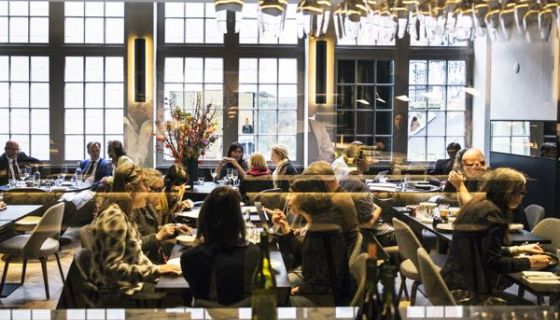Lunch and dinner at RIJKS, the new restaurant in the shadow of the Rijksmuseum in Amsterdam, not only broadened my hitherto limited knowledge of modern Dutch cooking but also introduced me to three of the five people responsible for its successful launch (photo: Rijksmuseum).
The most influential, and the most dapperly dressed in an electric blue suit, was Wim Pijbes, the museum’s director. He explained how the restaurant forms part of his strategy to open up the museum and how he, as a self-confessed foodie, was determined that the restaurant should display Dutch influence on food and drink.
On the counter in front of him was a cup of orange pekoe tea from Sri Lanka, long a Dutch trading partner, next to a plate of salt, butter and caramel biscuits from the city’s renowned Holtkamp bakery, while behind the bar the shelves are stocked with exclusively Dutch spirits. Pijbes explained that their wine list incorporates wines made from around the world but only where there is a Dutch influence, such as the winemaker. The same principle applies to their guest chef programme that had recently got under way with an appearance from Margot Janse of Le Quartier Français in Franschhoek, South Africa.
Loek Beeren is the experienced general manager from Vermaat Groep, the company that runs all the hospitality in the museum, including the spacious café, which had a turnover of 6.2 million euros last year and is in a joint venture with the museum, and also pays it a concession under the contract. Beeren is a restaurateur to his fingertips (as were his father and grandfather before him), who patrols the restaurant with determination that the service be friendly, attentive and swift.
His role is made easier, and his customers’ pleasure enhanced, by the presence behind the large, state-of-the-art open kitchen of the tall, blond executive chef, 30-year-old Joris Bijdendijk, whom I watched basting on the rotisserie an ingredient I had never before seen treated in such a manner.
The ten round items, with nicely browned skins, looked from where I was standing like small, juicy chickens or poussins. I assumed that they had had their wings and thighbones removed to make carving easier. In fact they were whole heads of celeriac that, I learnt, had been steamed for an hour and had then spent a further three hours rotating gently on the spit continuously basted with butter by one of the chefs in a cooking process that probably costs more than the celeriac itself.
The two other people who contributed in a major way to the success of RIJKS are father and son PJH and JTJ Cuypers, the architects who designed the Rijksmuseum in the late 19th century. In the early 20th century they also designed this smaller building to the left of the main entrance to house a private collection donated to the museum and it is this building that has now been converted into the restaurant.
It is a wonderful space, with high ceilings that lead to excellent acoustics, and numerous windows that make the restaurant feel casual by day and elegant by night. Just outside is a terrace that Beeren plans to fill with tables and chairs from the spring, and opposite is a garden and greenhouse in which Bijdendijk can grow his own vegetables. But most importantly for Pijbes and the museum’s finances, a separate building means the restaurant can establish its own identity and attract the higher-spending customers in the evening without incurring the hefty security charges that preclude this in many of London’s major museums.
That RIJKS has emerged from the combination of such talented individuals seemed fitting because what impressed me most about what I ate there was the unusual, but ultimately highly successful, combinations Bijdendijk constructs on his menu.

Herrings, very Dutch, are served here diced and topped with an unusual but winning topping of a lemon and champagne chutney (photo by Jan Kees Steenman). However, on either side are two ingredients inspired by Margot Janse’s visit, a small mound of vetkoek, fried dough balls, and a bowl of oyster braaioli, a sauce made from pureed, grilled oysters that in turn acknowledges the South African penchant for the braai or grill. Two pancakes held a mound of diced wild duck and two slices of pink breast and were to be rolled with dogwood berries to form a Dutch interpretation of Peking duck while an intense apple foam added bite and acidity to a slow-cooked beef cheek, a speciality of Limburg in the south of Holland.
In the evening, accompanied by two friends who grew up in Amsterdam, one of whom is an enthusiastic cook, further fascinating combinations were to impress us all. There was a spicier version of gado gado, the Indonesian dish, here enlivened by Korean kimchee; cod with Brussels sprout leaves and smoked eel served as a mousse; and, finally, the spit-roasted celeriac, released from its outer skin and served as a dark yellow, unctuous vegetable surrounded by a strip of Messenklever cheese, the only soft cheese produced in Holland, and a slowly cooked egg yolk. Main courses, halibut with a local chorizo, and a Chaamse chicken cooked in two different styles, were equally impressive.
The management of museums around the world – in New York, Paris, Bilbao and San Francisco – are establishing restaurants of note. Those behind RIJKS have put on a particularly distinctive and successful show.
RIJKS, Museumstraat 2, Amsterdam; tel +31 20 6747 555














